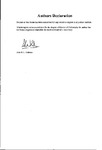Fatigue of a spring steel with varying levels of non-metallic inclusions
| dc.contributor.author | Holman, Alan Edwin Lee | |
| dc.contributor.other | Faculty of Science and Engineering | en_US |
| dc.date.accessioned | 2013-10-03T09:21:08Z | |
| dc.date.available | 2013-10-03T09:21:08Z | |
| dc.date.issued | 2001 | |
| dc.identifier | NOT AVAILABLE | en_US |
| dc.identifier.uri | http://hdl.handle.net/10026.1/1980 | |
| dc.description.abstract |
Plain specimens of two batches of the commercial spring steel BS 251A58 of nominally identical processing but significantly differing levels of non-metallic inclusion levels, have been tested in rotating bending. The data produced has been analysed against some recent methods for the prediction of fatigue properties in high strength materials containing defects. The materials tested were specifically selected for their disparate cleanliness levels, yielding specimens with differing inclusion distribution and maxima. The morphology of critical inclusions is identical between the two material batches. Material microstructure is tempered martensite with ultimate tensile strength of approximately 2000 MPa, which renders it well above the strength level where sensitivity to defects causes variability in fatigue behaviour. Models have been selected from the literature for the prediction of fatigue limit using characterisation of the local microstructural state and the size and critical position of non-metallic inclusions. These models have been validated by the analysis of specific failures after fractographic analysis. It has been shown that these models are acceptably accurate and generally conservative. Difficulties in experimental work have precluded the planned measurement of crack growth rates during the current test work. These difficulties have yielded a superimposed mean stress to the rotating bend test. This mean stress has been quantified for each test and the result coupled with a parameter for mean stress correction. The validity of the mean stress correction has been proven in this work to be valid. More consistent results are observed for the mean stress corrected data. A statistical method for the prediction of maximum non-metallic inclusion size for a given number of specimens or components from small sample microsection analyses has yielded good results when compared to the fractographic observations. This work has investigated the effect of varying magnification level and number of fields surveyed on the accuracy of prediction and recommendations are made for the method for obtaining best accuracy. A 'unified' crack propagation life model from the literature has been applied which combines long and short crack growth regimes. The model has shown good correlation to the current data but only after fitting of constants and only within the low cycle regime. Relationships presented in the literature between constants and the material ultimate tensile strength were found to be inapplicable to the current material at this strength level. | en_US |
| dc.language.iso | en | en_US |
| dc.publisher | University of Plymouth | en_US |
| dc.title | Fatigue of a spring steel with varying levels of non-metallic inclusions | en_US |
| dc.type | Thesis | |
| plymouth.version | Full version | en_US |
| dc.identifier.doi | http://dx.doi.org/10.24382/4443 |
Files in this item
This item appears in the following Collection(s)
-
01 Research Theses Main Collection
Research Theses Main


